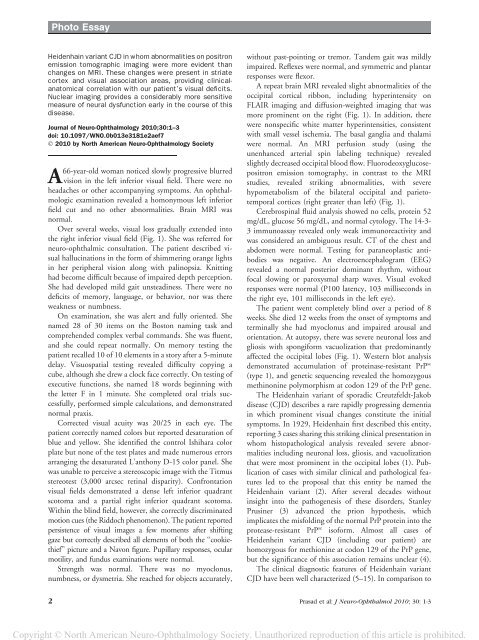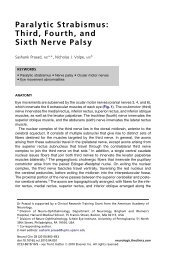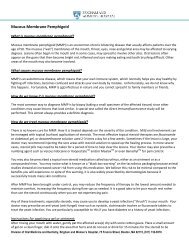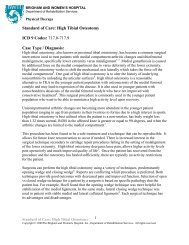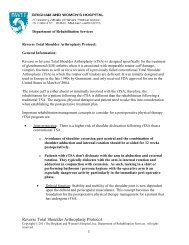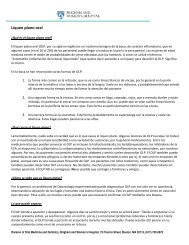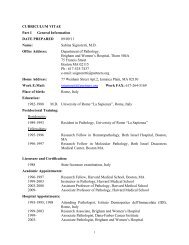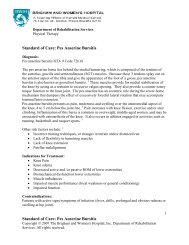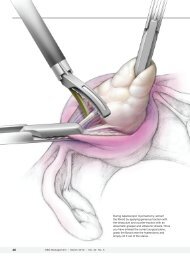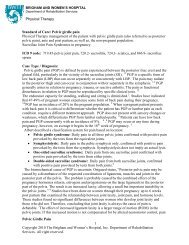MRI and Positron Emission Tomography Findings in Heidenhain ...
MRI and Positron Emission Tomography Findings in Heidenhain ...
MRI and Positron Emission Tomography Findings in Heidenhain ...
You also want an ePaper? Increase the reach of your titles
YUMPU automatically turns print PDFs into web optimized ePapers that Google loves.
Copyright © North American Neuro-Ophthalmology Society. Unauthorized reproduction of this article is prohibited.<br />
Photo Essay<br />
Heidenha<strong>in</strong> variant CJD <strong>in</strong> whom abnormalities on positron<br />
emission tomographic imag<strong>in</strong>g were more evident than<br />
changes on <strong>MRI</strong>. These changes were present <strong>in</strong> striate<br />
cortex <strong>and</strong> visual association areas, provid<strong>in</strong>g cl<strong>in</strong>icalanatomical<br />
correlation with our patient’s visual deficits.<br />
Nuclear imag<strong>in</strong>g provides a considerably more sensitive<br />
measure of neural dysfunction early <strong>in</strong> the course of this<br />
disease.<br />
Journal of Neuro-Ophthalmology 2010;30:1–3<br />
doi: 10.1097/WNO.0b013e3181e2aef7<br />
Ó 2010 by North American Neuro-Ophthalmology Society<br />
A66-year-old woman noticed slowly progressive blurred<br />
vision <strong>in</strong> the left <strong>in</strong>ferior visual field. There were no<br />
headaches or other accompany<strong>in</strong>g symptoms. An ophthalmologic<br />
exam<strong>in</strong>ation revealed a homonymous left <strong>in</strong>ferior<br />
field cut <strong>and</strong> no other abnormalities. Bra<strong>in</strong> <strong>MRI</strong> was<br />
normal.<br />
Over several weeks, visual loss gradually extended <strong>in</strong>to<br />
the right <strong>in</strong>ferior visual field (Fig. 1). She was referred for<br />
neuro-ophthalmic consultation. The patient described visual<br />
halluc<strong>in</strong>ations <strong>in</strong> the form of shimmer<strong>in</strong>g orange lights<br />
<strong>in</strong> her peripheral vision along with pal<strong>in</strong>opsia. Knitt<strong>in</strong>g<br />
had become difficult because of impaired depth perception.<br />
She had developed mild gait unstead<strong>in</strong>ess. There were no<br />
deficits of memory, language, or behavior, nor was there<br />
weakness or numbness.<br />
On exam<strong>in</strong>ation, she was alert <strong>and</strong> fully oriented. She<br />
named 28 of 30 items on the Boston nam<strong>in</strong>g task <strong>and</strong><br />
comprehended complex verbal comm<strong>and</strong>s. She was fluent,<br />
<strong>and</strong> she could repeat normally. On memory test<strong>in</strong>g the<br />
patient recalled 10 of 10 elements <strong>in</strong> a story after a 5-m<strong>in</strong>ute<br />
delay. Visuospatial test<strong>in</strong>g revealed difficulty copy<strong>in</strong>g a<br />
cube, although she drew a clock face correctly. On test<strong>in</strong>g of<br />
executive functions, she named 18 words beg<strong>in</strong>n<strong>in</strong>g with<br />
the letter F <strong>in</strong> 1 m<strong>in</strong>ute. She completed oral trials successfully,<br />
performed simple calculations, <strong>and</strong> demonstrated<br />
normal praxis.<br />
Corrected visual acuity was 20/25 <strong>in</strong> each eye. The<br />
patient correctly named colors but reported desaturation of<br />
blue <strong>and</strong> yellow. She identified the control Ishihara color<br />
plate but none of the test plates <strong>and</strong> made numerous errors<br />
arrang<strong>in</strong>g the desaturated L’anthony D-15 color panel. She<br />
was unable to perceive a stereoscopic image with the Titmus<br />
stereotest (3,000 arcsec ret<strong>in</strong>al disparity). Confrontation<br />
visual fields demonstrated a dense left <strong>in</strong>ferior quadrant<br />
scotoma <strong>and</strong> a partial right <strong>in</strong>ferior quadrant scotoma.<br />
With<strong>in</strong> the bl<strong>in</strong>d field, however, she correctly discrim<strong>in</strong>ated<br />
motion cues (the Riddoch phenomenon). The patient reported<br />
persistence of visual images a few moments after shift<strong>in</strong>g<br />
gaze but correctly described all elements of both the ‘‘cookiethief’’<br />
picture <strong>and</strong> a Navon figure. Pupillary responses, ocular<br />
motility, <strong>and</strong> fundus exam<strong>in</strong>ations were normal.<br />
Strength was normal. There was no myoclonus,<br />
numbness, or dysmetria. She reached for objects accurately,<br />
without past-po<strong>in</strong>t<strong>in</strong>g or tremor. T<strong>and</strong>em gait was mildly<br />
impaired. Reflexes were normal, <strong>and</strong> symmetric <strong>and</strong> plantar<br />
responses were flexor.<br />
A repeat bra<strong>in</strong> <strong>MRI</strong> revealed slight abnormalities of the<br />
occipital cortical ribbon, <strong>in</strong>clud<strong>in</strong>g hyper<strong>in</strong>tensity on<br />
FLAIR imag<strong>in</strong>g <strong>and</strong> diffusion-weighted imag<strong>in</strong>g that was<br />
more prom<strong>in</strong>ent on the right (Fig. 1). In addition, there<br />
were nonspecific white matter hyper<strong>in</strong>tensities, consistent<br />
with small vessel ischemia. The basal ganglia <strong>and</strong> thalami<br />
were normal. An <strong>MRI</strong> perfusion study (us<strong>in</strong>g the<br />
unenhanced arterial sp<strong>in</strong> label<strong>in</strong>g technique) revealed<br />
slightly decreased occipital blood flow. Fluorodeoxyglucosepositron<br />
emission tomography, <strong>in</strong> contrast to the <strong>MRI</strong><br />
studies, revealed strik<strong>in</strong>g abnormalities, with severe<br />
hypometabolism of the bilateral occipital <strong>and</strong> parietotemporal<br />
cortices (right greater than left) (Fig. 1).<br />
Cerebrosp<strong>in</strong>al fluid analysis showed no cells, prote<strong>in</strong> 52<br />
mg/dL, glucose 56 mg/dL, <strong>and</strong> normal cytology. The 14-3-<br />
3 immunoassay revealed only weak immunoreactivity <strong>and</strong><br />
was considered an ambiguous result. CT of the chest <strong>and</strong><br />
abdomen were normal. Test<strong>in</strong>g for paraneoplastic antibodies<br />
was negative. An electroencephalogram (EEG)<br />
revealed a normal posterior dom<strong>in</strong>ant rhythm, without<br />
focal slow<strong>in</strong>g or paroxysmal sharp waves. Visual evoked<br />
responses were normal (P100 latency, 103 milliseconds <strong>in</strong><br />
the right eye, 101 milliseconds <strong>in</strong> the left eye).<br />
The patient went completely bl<strong>in</strong>d over a period of 8<br />
weeks. She died 12 weeks from the onset of symptoms <strong>and</strong><br />
term<strong>in</strong>ally she had myoclonus <strong>and</strong> impaired arousal <strong>and</strong><br />
orientation. At autopsy, there was severe neuronal loss <strong>and</strong><br />
gliosis with spongiform vacuolization that predom<strong>in</strong>antly<br />
affected the occipital lobes (Fig. 1). Western blot analysis<br />
demonstrated accumulation of prote<strong>in</strong>ase-resistant PrP sc<br />
(type 1), <strong>and</strong> genetic sequenc<strong>in</strong>g revealed the homozygous<br />
meth<strong>in</strong>on<strong>in</strong>e polymorphism at codon 129 of the PrP gene.<br />
The Heidenha<strong>in</strong> variant of sporadic Creutzfeldt-Jakob<br />
disease (CJD) describes a rare rapidly progress<strong>in</strong>g dementia<br />
<strong>in</strong> which prom<strong>in</strong>ent visual changes constitute the <strong>in</strong>itial<br />
symptoms. In 1929, Heidenha<strong>in</strong> first described this entity,<br />
report<strong>in</strong>g 3 cases shar<strong>in</strong>g this strik<strong>in</strong>g cl<strong>in</strong>ical presentation <strong>in</strong><br />
whom histopathological analysis revealed severe abnormalities<br />
<strong>in</strong>clud<strong>in</strong>g neuronal loss, gliosis, <strong>and</strong> vacuolization<br />
that were most prom<strong>in</strong>ent <strong>in</strong> the occipital lobes (1). Publication<br />
of cases with similar cl<strong>in</strong>ical <strong>and</strong> pathological features<br />
led to the proposal that this entity be named the<br />
Heidenha<strong>in</strong> variant (2). After several decades without<br />
<strong>in</strong>sight <strong>in</strong>to the pathogenesis of these disorders, Stanley<br />
Prus<strong>in</strong>er (3) advanced the prion hypothesis, which<br />
implicates the misfold<strong>in</strong>g of the normal PrP prote<strong>in</strong> <strong>in</strong>to the<br />
protease-resistant PrP sc isoform. Almost all cases of<br />
Heidenhe<strong>in</strong> variant CJD (<strong>in</strong>clud<strong>in</strong>g our patient) are<br />
homozygous for methion<strong>in</strong>e at codon 129 of the PrP gene,<br />
but the significance of this association rema<strong>in</strong>s unclear (4).<br />
The cl<strong>in</strong>ical diagnostic features of Heidenha<strong>in</strong> variant<br />
CJD have been well characterized (5–15). In comparison to<br />
2 Prasad et al: J Neuro-Ophthalmol 2010; 30: 1-3


